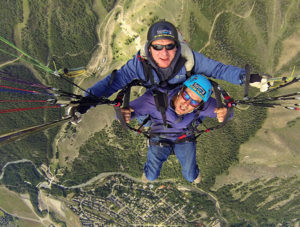“I’ve flown all over the world, and Baldy is one of the most demanding mountains I’ve found,” said Chuck Smith, owner of Fly Sun Valley, the commercial paragliding operation that’s been launching clients off the top of the mountain for the past 16 years. “No flight is ever the same, and it keeps you on your toes. That’s why the flying here is so good and the pilots are so skilled.”
Sitting on the border of two different topographical areas, with the flatlands of the Camas Prairie to the south and the ring of mountains on the remaining three sides, Bald Mountain has been attracting paragliders and speed flyers to the area since the sport was introduced in America. These features make it difficult to predict the weather but also create systems that allow for some of the longest endurance flights in the U.S., including the national record, held by Gavin McClurg, who took off from Baldy and landed in Montana, 240 miles away.
“It’s like a chess game that’s just you and the elements,” said Smith, relaxing in his office in Ketchum after a busy morning of flying. “You’re navigating this invisible landscape, constantly looking ahead a few moves to visualize what the air is doing and then making critical judgment calls.”
With nearly three decades of flying, which began above the dunes of Cape Cod, Smith surely has the breadth of experience and the skillset to know, traits that he looks for in the half-dozen pilots under his employ to take clients on tandem flights off the summit of Baldy.

The duration of these flights greatly depends on the weather and the time of day, but during the summer—and, yes, people fly in the middle of winter as well—they average about 30 minutes, giving passengers one of the most spectacular perspectives from approximately 12,000 feet above the floor of the Wood River Valley. In addition to the scenery, this type of flying offers a unique sensation, with the foil 15 feet above so that there is an unimpeded view of the Pioneer, Smoky, Boulder and White Cloud mountain ranges.
“I could see forever,” exclaimed Hensley Green, a 15-year-old from Alabama who had just landed on a warm July morning. “It was awesome and an adrenaline rush running off the top of the mountain.”
Green, visiting the Valley for the first time with her family, had done a tandem flight with four others. She was excited to do it again, hoping to get her mother along this time. As Smith noted, they have taken clients from age 3 to 93 off the mountain, tailoring the experience to the wishes of their passengers.
“It was like a rollercoaster for me,” said Green. “We slalomed over the ski runs and got to say hi to a hiker below, and at the end, we got to spin around.”
Paragliders aren’t the only ones jumping off of these mountains, however. Speed flyers, who use a wing designed not to soar, but rather to descend quickly and in control, can also be seen coming off of a number of mountains throughout the Valley. In addition to having less volume in the wing, a speed-flying rig is smaller. Whereas a paraglider essentially has a seat attached (think a Crazy Creek on steroids), a speed wing harness is more like a little hammock that straps to your legs, waist and chest.
Sarah Murphy, a 34-year-old Web developer and graphic designer, has been living in the Valley for four years. She relocated here in part because of the opportunities to fly.
“I kind of got into it backwards,” said Murphy, who started skydiving in Alaska, transitioned to BASE-jumping and finally paragliding and speed flying. “I began paragliding because it’s safer and very relaxing and Zen-like compared to the others.”
Still, she prefers to speed fly, in part because the lower weight of the wing allows her to hike and fly, which she often does in wintertime with her skis attached.
Murphy is part of a small but tight-knit community of speed flyers in the Valley. She estimates that there are about 10 pilots who fly nearly every day. She also readily admits that the sport isn’t for everyone, as there’s a cost of entry that not only includes equipment, with a wing running anywhere from $2,000 to $8,000, but also the need for significant training.
“It’s a solo sport, so if you’re going to do it, you need to get the right training because no one is there to fix an issue for you,” said Murphy. She described an incident in which her wing collapsed on her while flying near Mackay, exposing her self-described false sense of security that had her pushing
her limits.
“You need to be adventurous to get into the sport, and with speed and momentum, you’re definitely committed to what you’re doing,” Murphy said. “But the main appeal is the view—it really is the best in the house around here.”

